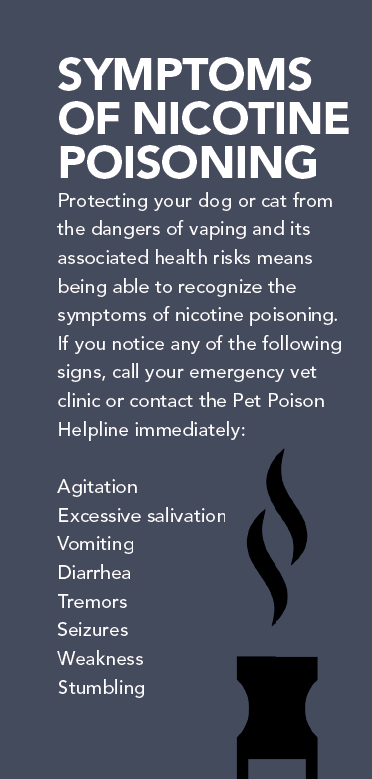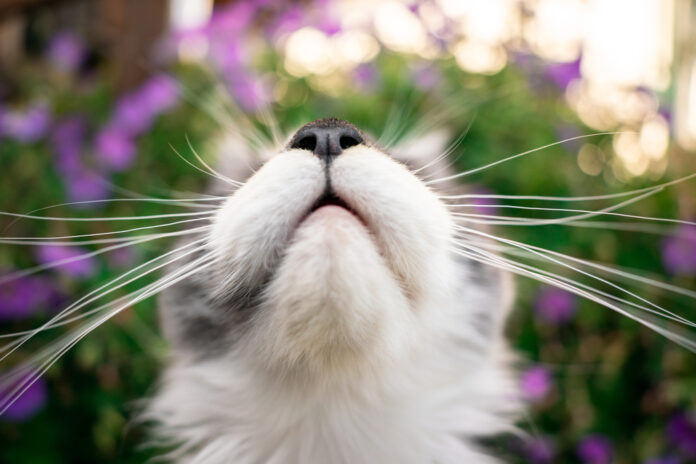How vaping impacts your dog or cat

Many people assume vaping is a harmless habit that emits nothing but water vapor. But the “e-juice” in vape pens contains chemicals that pose a danger to the people – and animals – who are exposed to it.
Chances are, you know at least one person who vapes. This trend has taken off in the past couple of years, and is slowly replacing cigarettes with many people. In some ways, this is a positive shift. Compared to traditional cigarettes, vape pens contain fewer carcinogenic compounds, and pose less of a risk to humans and animals when it comes to lung health. For this reason, many people use vaping as a way to quit smoking. The catch, however, is that the liquid used in vape pens contains a whole host of other toxic chemicals, that when ingested or inhaled, can cause harm to people, dogs and cats.
What is vaping, exactly?
When someone vapes, he or she inhales the aerosol produced by a liquid, commonly known as e-juice, heated by a vape pen or “e-cigarette”. While no burning is involved, the act of heating the chemicals in the e-juice can create new (and more dangerous) chemicals, such as formaldehyde.
E-juice itself can contain numerous ingredients, most of which are dangerous to dogs and cats. Some may include carrier solvents such as propylene glycol and vegetable glycerin, and additional contents that include flavoring compounds and nicotone. In locations where marijuana is legal, THC-infused e-juice might also be available. It’s a misconception that vape pens contain less nicotine than traditional cigarettes. The truth is, levels can vary, and some may actually contain quite a bit more.
Understanding the risks
The risks of vaping around dogs and cats is twofold. The first potential danger is second-hand inhalation of the vapor. The second and more fatal risk is ingestion of the nicotine present in the e-juice, or ingestion of the vape pens themselves.
Risk #1: Inhalation
The risk of second-hand exposure to vape aerosols is significantly less dangerous than that associated with cigarette smoke – but that doesn’t mean it’s safe. In 2016, the World Health Organization concluded that second-hand aerosols from e-cigarettes are an air contamination source of hazardous particulate matter, which poses a risk to anyone breathing it in.1 For this reason, many jurisdictions have banned vaping in public areas. Not surprisingly, the risk goes up for children and animals, who are smaller and more susceptible to the effects of air pollution.

A study published in the International Journal of Hygiene and Environmental Health revealed that vaping worsened indoor air quality as a result of the nicotine, hydrocarbons and aluminum found in e-juice.2 Another found that propylene glycol (commonly found in e-juice) can lead to red blood cell damage in cats.3 Particles from the exhaled aerosol can settle on an animal’s fur, where it will be ingested when he grooms himself. “At this time, there is limited study about the impact on human health of second-hand and third-hand exposure to electronic cigarettes,” says veterinarian Dr. Angie Krause. “What we do know is that second-hand smoke can affect a pet’s respiratory health and increase his risk for cancer of the lungs, nasal cavity and sinuses. Electronic cigarettes may lessen these risks but not eliminate them completely.”
Risk #2: Ingestion
The Pet Poison Helpline has witnessed a dramatic increase in calls from people with dogs and cats that have ingested e-cigarettes or e-juice. According to their website, the victims are usually dogs, but these substances are toxic to cats as well. The smell of the e-juice, whether the latter is flavored or not, can be appealing to animals. But while the flavoring and propylene glycol is certainly harmful, the nicotine is the primary danger. “Nicotine is toxic to pets because it causes depolarization in the nervous system,” says Dr. Krause. “This causes stimulation at first, followed by depression. Respiratory depression can be fatal. The liquid nicotine cartridges contain concentrated levels of nicotine, which is readily absorbed in the mouth while the pet is chewing.”

Unfortunately, some animals are more at risk than others. Large breed dogs and mixes, for instance, may get sick from ingesting a small amount of nicotine, but the same amount might be fatal in a small canine or a cat. In either case, it’s important to seek help immediately in order to minimize the risks.
In addition to poisoning risk, ingesting the cartridge or the pen itself can cause a fatal blockage in an animal’s GI system.
The long-term health effects of vaping around dogs and cats might still be unclear, but it’s safe to say they’re probably not good – for you or your furry friends. If you can’t kick the habit, be responsible about it. Your dog or cat’s life might depend on it.
1www.who.int/bulletin/volumes/95/7/16-186536/en/
2www.sciencedirect.com/science/article/pii/S1438463913001533
3www.ncbi.nlm.nih.gov/pubmed/2708106



